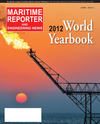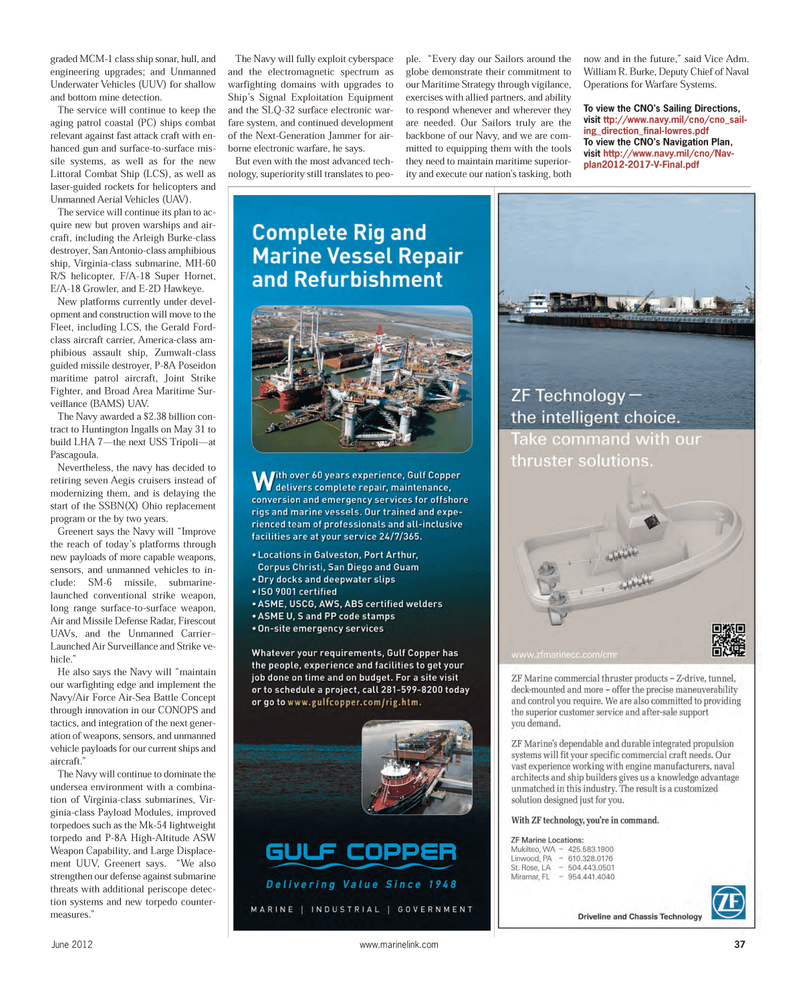
Page 37: of Maritime Reporter Magazine (June 2012)
Annual World Yearbook
Read this page in Pdf, Flash or Html5 edition of June 2012 Maritime Reporter Magazine
graded MCM-1 class ship sonar, hull, and engineering upgrades; and UnmannedUnderwater Vehicles (UUV) for shallow and bottom mine detection. The service will continue to keep the aging patrol coastal (PC) ships combatrelevant against fast attack craft with en- hanced gun and surface-to-surface mis- sile systems, as well as for the new Littoral Combat Ship (LCS), as well aslaser-guided rockets for helicopters and Unmanned Aerial Vehicles (UAV). The service will continue its plan to ac-quire new but proven warships and air- craft, including the Arleigh Burke-class destroyer, San Antonio-class amphibious ship, Virginia-class submarine, MH-60 R/S helicopter, F/A-18 Super Hornet, E/A-18 Growler, and E-2D Hawkeye. New platforms currently under devel- opment and construction will move to the Fleet, including LCS, the Gerald Ford- class aircraft carrier, America-class am- phibious assault ship, Zumwalt-class guided missile destroyer, P-8A Poseidon maritime patrol aircraft, Joint Strike Fighter, and Broad Area Maritime Sur- veillance (BAMS) UAV. The Navy awarded a $2.38 billion con- tract to Huntington Ingalls on May 31 to build LHA 7?the next USS Tripoli?at Pascagoula. Nevertheless, the navy has decided to retiring seven Aegis cruisers instead of modernizing them, and is delaying thestart of the SSBN(X) Ohio replacementprogram or the by two years. Greenert says the Navy will ?Improve the reach of today?s platforms through new payloads of more capable weapons, sensors, and unmanned vehicles to in- clude: SM-6 missile, submarine-launched conventional strike weapon, long range surface-to-surface weapon, Air and Missile Defense Radar, Firescout UAVs, and the Unmanned Carrier? Launched Air Surveillance and Strike ve- hicle.? He also says the Navy will ?maintain our warfighting edge and implement the Navy/Air Force Air-Sea Battle Concept through innovation in our CONOPS and tactics, and integration of the next gener- ation of weapons, sensors, and unmannedvehicle payloads for our current ships and aircraft.? The Navy will continue to dominate the undersea environment with a combina- tion of Virginia-class submarines, Vir- ginia-class Payload Modules, improved torpedoes such as the Mk-54 lightweighttorpedo and P-8A High-Altitude ASW Weapon Capability, and Large Displace- ment UUV, Greenert says. ?We also strengthen our defense against submarine threats with additional periscope detec-tion systems and new torpedo counter- measures.? The Navy will fully exploit cyberspace and the electromagnetic spectrum aswarfighting domains with upgrades to Ship?s Signal Exploitation Equipment and the SLQ-32 surface electronic war- fare system, and continued development of the Next-Generation Jammer for air- borne electronic warfare, he says. But even with the most advanced tech- nology, superiority still translates to peo- ple. ?Every day our Sailors around the globe demonstrate their commitment toour Maritime Strategy through vigilance, exercises with allied partners, and ability to respond whenever and wherever they are needed. Our Sailors truly are thebackbone of our Navy, and we are com- mitted to equipping them with the toolsthey need to maintain maritime superior- ity and execute our nation's tasking, both now and in the future,? said Vice Adm. William R. Burke, Deputy Chief of Naval Operations for Warfare Systems. To view the CNO's Sailing Directions, visit ttp://www.navy.mil/cno/cno_sail- ing_direction_final-lowres.pdf To view the CNO's Navigation Plan, visit http://www.navy.mil/cno/Nav- plan2012-2017-V-Final.pdfJune 2012www.marinelink.com 37MR June12 # 5 (34-41):MR Template 6/13/2012 9:24 AM Page 37

 36
36

 38
38
